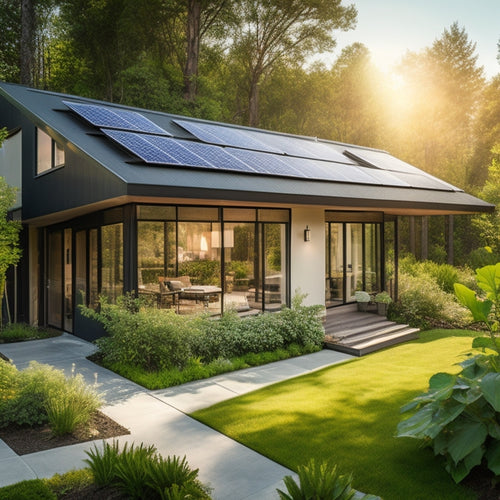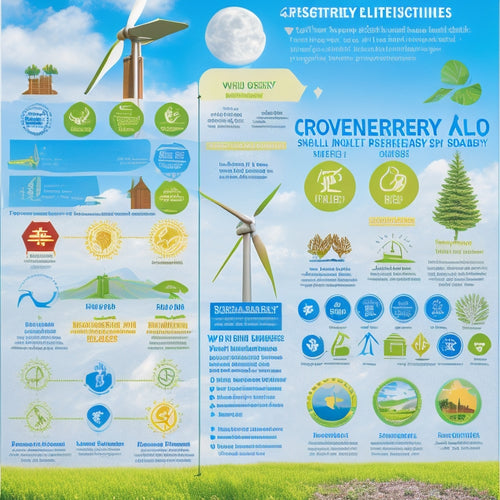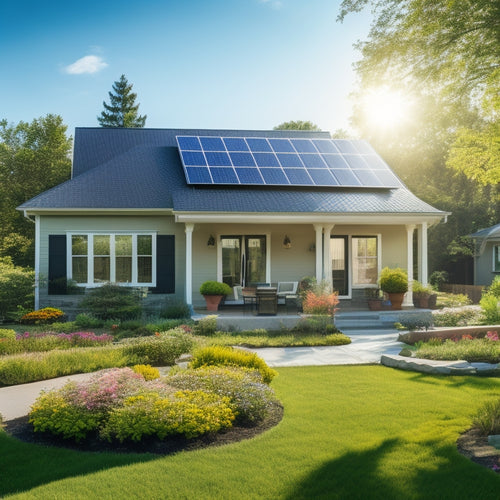
Why Residential Solar Panel System Prices Vary Online
Share
Residential solar panel system prices vary online due to several factors. Brand differences are a major influence; high-efficiency brands like SunPower cost more but offer better durability and warranties. System sizes depend on energy consumption and available space, affecting overall cost. Panel efficiency, leveraging premium materials and technology, boosts energy yield, raising prices. Installation costs, labor rates, and permits can differ regionally. Government incentives such as tax credits and rebates also play a role in cost variation. Warranty options and market demand further impact pricing. Exploring these elements reveals deeper insights into the complexities of solar panel pricing.
Key Takeaways
- Brand Differences: High-efficiency brands like SunPower and LG have higher prices due to superior performance and durability.
- System Sizes: Larger systems cost more upfront but offer greater long-term savings and potential for future expansion.
- Panel Efficiency: High-efficiency panels with premium materials cost more but provide better energy output and warranties.
- Installation Costs: Regional labor rates, permit fees, and equipment quality significantly impact installation costs.
- Government Incentives: Availability of federal, state, and local incentives can reduce overall costs and vary by region.
Brand Differences
https://www.youtube.com/watch?v=kP8KO1gWOjk
When comparing residential solar panel systems, brand differences have a significant impact on performance, efficiency, and cost. You'll find that brand reputation plays an essential role in your decision-making process.
Established brands like SunPower and LG are known for their high efficiency rates, often exceeding 20%, which translates to more electricity generation per square meter of your roof. In contrast, lesser-known brands might offer lower upfront costs but can fall short in long-term reliability and performance.
Customer reviews are your secret weapon in navigating this landscape. High-rated brands consistently receive positive feedback for their durability and customer service. For instance, SunPower panels typically receive glowing reviews for their longevity and robust warranties, which can extend up to 25 years. Conversely, brands with mixed or negative reviews often reveal issues such as rapid degradation or poor customer support, which can be a red flag.
Industry insights show that while top-tier brands come with a higher price tag, their superior performance and longer lifespan often justify the investment.
System Sizes
Understanding the ideal system size for your residential solar panel installation is essential to maximizing energy production and financial savings. When determining the appropriate size, you must consider your household's custom requirements and projected energy needs.
Start by analyzing your past utility bills to gauge your average monthly consumption. This data helps estimate the kilowatt capacity required to meet your energy demands effectively.
It's also vital to factor in the potential for future expansions. If you plan to add an electric vehicle or expand your home, you'll need a system that can accommodate these increased energy needs. Industry standards suggest that a typical home may require a 5kW to 10kW system, but this can vary significantly based on your specific circumstances.
Moreover, the physical space available on your roof can influence the system size. Larger systems usually come with higher upfront costs but offer greater long-term savings. Calculating the return on investment (ROI) based on these variables will guide you in selecting a system size that aligns with both your present and future energy goals.
Using data-driven insights ensures that your investment in solar technology liberates you from rising energy costs and contributes to a sustainable lifestyle.
Panel Efficiency
When considering panel efficiency, you should focus on the technology and material quality, as these directly influence energy output levels.
High-efficiency panels, often made with monocrystalline silicon, can convert more sunlight into electricity, resulting in greater energy savings.
Additionally, weather resistance factors, such as durability against hail and high winds, play an important role in maintaining consistent performance over time.
Technology and Material Quality
How does the efficiency of solar panels impact the overall performance and cost-effectiveness of your residential solar panel system?
High-efficiency panels convert more sunlight into electricity, which means you need fewer panels to meet your energy needs. This can save space and reduce installation costs. Additionally, efficient panels often come with advanced inverter technology that optimizes energy conversion and enhances system reliability. Quality mounting systems are also essential; they guarantee your panels are securely positioned for maximum sunlight exposure and longevity.
When considering panel efficiency, keep these factors in mind:
-
Energy Yield: Higher efficiency panels produce more electricity per square meter, maximizing your roof's output.
-
Cost per Watt: While high-efficiency panels can be more expensive upfront, they often offer a lower cost per watt over their lifespan.
-
Space Constraints: Efficient panels are ideal for smaller roofs, allowing you to generate sufficient power without needing extensive space.
-
Durability: Premium materials in high-efficiency panels often come with better warranties, ensuring long-term performance.
-
Compatibility: Efficient panels work well with advanced inverter technology and robust mounting systems, guaranteeing seamless integration and excellent performance.
Energy Output Levels
Panel efficiency directly determines the energy output levels of your residential solar system, impacting both the amount of electricity generated and the overall system's return on investment. High-efficiency panels convert more sunlight into electricity, which means you can generate more power from the same amount of sunlight. This directly affects your system capacity, allowing you to either use fewer panels for the same output or maximize energy production with your existing setup.
When evaluating panel efficiency, you'll notice a range from around 15% to over 22%. Panels on the higher end of this spectrum might cost more initially but can offer better long-term savings due to their higher energy output. Efficiency also ties into output degradation, which refers to the gradual loss of panel performance over time. High-quality, efficient panels typically degrade at a slower rate, retaining more of their initial capacity even after decades of use.
Investing in efficient panels can liberate you from rising electricity costs and reduce your carbon footprint more effectively. By understanding how panel efficiency influences system capacity and output degradation, you can make informed decisions that align with your financial and environmental goals.
Weather Resistance Factors
Weather resistance is an essential factor that greatly impacts the efficiency and longevity of your residential solar panel system. Panels exposed to harsh climate conditions, such as heavy snow, strong winds, and extreme temperatures, must be built with high material durability to maintain peak performance.
When evaluating the weather resistance of solar panels, you need to take into account several key aspects:
-
Material Quality: High-grade materials like tempered glass and corrosion-resistant metals guarantee panels can withstand environmental stress.
-
Temperature Coefficient: Panels with a low temperature coefficient lose less efficiency under high temperatures, important for hot climates.
-
Snow Load Rating: This rating indicates how much weight from snow the panel can support, crucial for regions with heavy snowfall.
-
Wind Load Rating: Panels should be rated to endure high winds, especially in hurricane-prone areas.
-
Waterproofing: Effective sealing and waterproof designs prevent water ingress, safeguarding internal components from damage.
Installation Costs
Accurately estimating installation costs for your residential solar panel system requires understanding various factors such as labor rates, equipment quality, and regional pricing differences.
Labor fees are a significant component, often varying based on the complexity of the installation and the expertise required. Skilled labor ensures that your system is installed efficiently and safely, mitigating potential future issues.
Permit requirements also play an important role in the total cost. Local governments typically mandate permits to guarantee that installations meet safety and building codes. The fees for these permits can differ widely depending on your location, and they add to the overall expense. Neglecting this step can result in fines and delays, which is why it's important to account for these costs upfront.
Moreover, the quality of the equipment you choose impacts installation costs. Higher-quality components might require specialized installation techniques, which can increase labor fees. However, investing in premium equipment can offer long-term savings through higher efficiency and longer lifespan.
Regional Pricing
Regional pricing for residential solar panel systems varies greatly due to factors such as local labor costs, state incentives, and utility rates. These elements create a complex landscape, making it essential to understand regional differences when evaluating solar installation.
Local labor costs can greatly influence the final price. In areas with higher wages, expect to pay more for installation services. Regional supply chains also play an important role. If your area relies on imported solar components, additional shipping and handling costs might inflate prices. Additionally, utility rates can impact the cost-effectiveness of solar energy. In regions with high electricity rates, solar panels may offer quicker returns on investment, affecting installation prices.
Here are some key factors to take into account:
-
Labor Costs: Vary by region; higher wages lead to higher installation prices.
-
Supply Chains: Local availability of components impacts overall costs.
-
Utility Rates: Higher local electricity rates can make solar more attractive.
-
Climate: Regions with more sunlight may see lower costs due to better efficiency.
-
Market Competition: More local installers can drive competitive pricing.
Understanding these factors will help you navigate regional pricing and make informed decisions about investing in residential solar panels. Embrace the knowledge to liberate yourself from fluctuating energy costs and move towards sustainable living.
Government Incentives
When considering residential solar panel systems, you should be aware of the significant government incentives available. Federal tax credits can reduce your installation costs by up to 30%, and many states offer additional regional incentive programs.
Eligibility for these rebates often depends on specific criteria, including system size and energy efficiency.
Tax Credit Opportunities
Capitalizing on tax credit opportunities can greatly reduce the initial investment required for a residential solar panel system. By leveraging available incentives such as federal rebates and state discounts, you can substantially lower your out-of-pocket expenses. The Federal Solar Investment Tax Credit (ITC) allows you to deduct 26% of the cost of installing a solar energy system from your federal taxes. This incentive can lessen the financial burden and make solar more accessible.
State discounts vary widely, but they can further decrease your costs. Some states offer additional tax credits, rebates, or performance-based incentives (PBIs) that reward you based on the energy your system produces. By understanding and utilizing these incentives, you can make a more informed and financially sound decision.
Consider these points when exploring tax credit opportunities:
-
Federal Rebates: Utilize the 26% ITC to lower your federal tax liability.
-
State Discounts: Investigate your state's specific incentives, which can range from tax credits to rebates.
-
Energy Savings: Calculate long-term savings from reduced energy bills.
-
Payback Period: Assess how quickly your investment will pay for itself.
-
Consult Professionals: Seek advice from solar installation experts to maximize your benefits.
These data-driven insights empower you to make a choice that aligns with both your financial and environmental goals.
Regional Incentive Programs
By tapping into various government incentive programs, you can greatly reduce the overall cost of installing a residential solar panel system. Many regions offer local discounts that greatly lower initial expenses. For instance, states like California and New York have important rebate programs that can cut your costs by thousands of dollars. Utility partnerships also play an essential role in offering financial relief. Utilities often collaborate with state and local governments to provide rebates, making solar more accessible.
Data shows that these rebates can cover up to 30% of the installation costs. Additionally, states with aggressive renewable energy goals often have the most profitable incentives. For example, Massachusetts offers the SMART program, which not only provides upfront discounts but also compensates you for the solar energy your system produces.
To maximize savings, you should research regional incentive programs thoroughly. Check your state and local government websites for the latest updates on available incentives. Also, consult your utility provider to see if they participate in any rebate programs.
Rebate Eligibility Criteria
To qualify for government rebate programs, you must meet specific eligibility criteria that vary by region and program type. Understanding these criteria can empower you to maximize savings and make informed decisions. The application process often involves meticulous steps and requires detailed verification documentation.
Here are some common criteria and procedural steps you might encounter:
- Residency Requirements: You need to prove your residence in the region offering the rebate.
- System Specifications: Your solar panel system must meet certain technical standards, including efficiency ratings and installation guidelines.
- Installation Dates: Rebates may only apply to systems installed within specific time frames.
- Professional Installation: Some programs mandate that a certified installer complete the installation.
- Energy Production Metrics: You must provide data on expected energy production as part of the verification documentation.
Navigating the application process can seem challenging, but it's essential for tapping into substantial financial benefits. These criteria support efficient, high-quality installations that contribute to broader energy goals.
Understanding and preparing for these requirements will set you on the path to energy independence, aligning with your desire for liberation from conventional energy costs. By staying informed and organized, you can successfully secure government incentives and enhance the affordability of your residential solar panel system.
Warranty Options
When evaluating residential solar panel systems, understanding the various warranty options is essential for ensuring long-term performance and protection. A key factor to take into account is the coverage length of the warranty. Most solar panel manufacturers offer product warranties that range from 10 to 25 years. These warranties typically cover defects in materials and workmanship. However, you should carefully examine what's included and excluded in the coverage length to avoid unexpected costs down the line.
Another important aspect is the labor warranty. This warranty covers the cost of labor for repairs and replacements, which can be a significant expense if issues arise. While some manufacturers include labor warranties as part of their standard packages, others might charge extra. Be sure to compare these offerings across different providers.
Moreover, performance warranties are also significant. They guarantee a certain level of energy production over time, usually 80-90% of the initial output after 25 years. By understanding these warranty options, you'll make more informed decisions, ensuring your investment in solar technology delivers the freedom and sustainability you seek.
Always read the fine print and ask questions to fully grasp what each warranty entails.
Market Demand
Given the rising concerns over climate change and increasing electricity costs, the market demand for residential solar panel systems has surged dramatically in recent years. As you've likely observed, consumer behavior is shifting towards more sustainable energy solutions. This trend isn't just a passing phase; it's driven by data showing significant long-term savings and environmental benefits.
Understanding market demand involves examining several factors:
-
Consumer Preferences: People are more aware and willing to invest in renewable energy.
-
Government Incentives: Tax credits and rebates make solar more affordable.
-
Technological Advancements: Improved efficiency and lower production costs boost adoption.
-
Supply Chain Dynamics: Disruptions or efficiencies in the supply chain can affect prices.
-
Global Market Trends: International policies and market conditions influence local pricing.
These factors collectively shape the pricing landscape for residential solar systems.
When demand spikes, it often strains the supply chain, leading to price fluctuations. Additionally, savvy consumers are now more informed, comparing prices and options online, which also impacts market dynamics.
Frequently Asked Questions
How Does Weather Impact the Effectiveness of Solar Panels?
Seasonal variations and cloud coverage greatly impact solar panel efficiency. During winter, shorter days and cloudier weather reduce energy production. Conversely, summer's longer, sunnier days maximize output, liberating you from higher energy costs.
What Is the Average Lifespan of a Residential Solar Panel System?
Imagine a marathon runner gradually slowing over decades. That's your solar panel system. With an average lifespan of 25-30 years, efficiency degradation is expected, but don't worry—most systems have a warranty period covering 25 years.
Are There Financing Options Available for Purchasing Solar Panel Systems?
Yes, you can find various loan options and flexible payment plans for solar panel systems. These financing methods empower you to break free from high utility bills while making the investment manageable and more accessible.
Can Solar Panels Increase the Value of My Home?
Think of solar panels as a golden ticket; they boost your property value to a great extent. By enhancing energy efficiency, your home becomes more attractive to buyers, often leading to increased property value, according to industry data.
How Do I Maintain and Clean My Solar Panels?
To maintain and clean your solar panels, conduct regular inspections to spot issues early. Use specialized cleaning tools, like a soft brush and mild detergent, to guarantee efficiency. Proper upkeep maximizes energy output and extends panel lifespan.
Related Posts
-

Integrating Solar Panels Into Home Design
Integrating solar panels into your home design greatly enhances energy efficiency and lowers utility bills while addi...
-

Renewable Energy Certifications for Businesses
Renewable energy certifications are essential for your business, showcasing your commitment to sustainability and enh...
-

Affordable Solar Panels for Home Use
Affordable solar panels offer you a smart way to cut down on energy costs while promoting sustainability. With govern...


